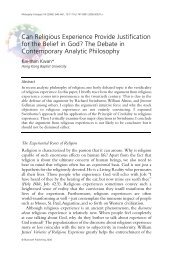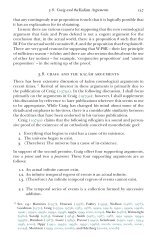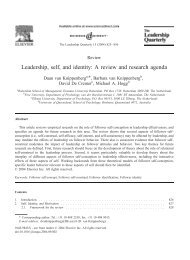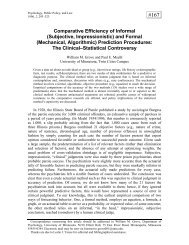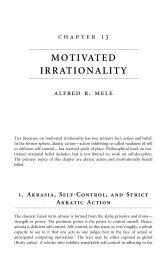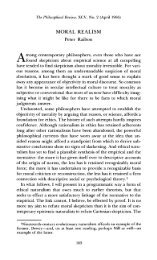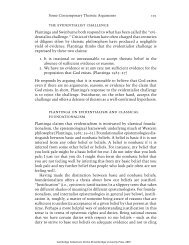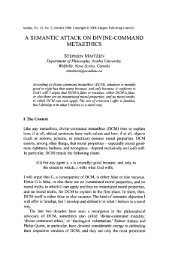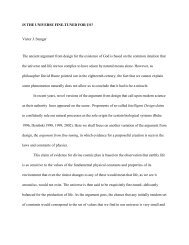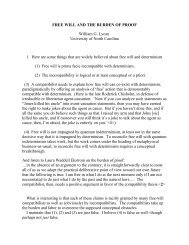The Cambridge Handbook of Expertise and Expert Performance
The Cambridge Handbook of Expertise and Expert Performance
The Cambridge Handbook of Expertise and Expert Performance
Create successful ePaper yourself
Turn your PDF publications into a flip-book with our unique Google optimized e-Paper software.
466 the cambridge h<strong>and</strong>book <strong>of</strong> expertise <strong>and</strong> expert performance<br />
at the top <strong>of</strong> the list. <strong>The</strong>re may also exist an<br />
upper limit for attainable performance with<br />
regard to the neuroplastic changes (Lim &<br />
Altenmüller, 2003). Focal dystonia, a condition<br />
where, for instance, fingers start to<br />
perform involuntary movements when other<br />
fingers are activated, may be due to an<br />
overlap <strong>of</strong> exp<strong>and</strong>ed cortical representations<br />
(Elbert et al., 1998). <strong>The</strong> gradual enlargement<br />
<strong>of</strong> the cortical representations in the<br />
somatosensory cortex during acquisition <strong>of</strong><br />
expertise might reach a limit when the<br />
separation between adjacent areas becomes<br />
blurred, resulting in uncontrollable coactivation<br />
<strong>of</strong> one finger through the use <strong>of</strong> another.<br />
It is obvious that research about physiological<br />
limits <strong>of</strong> musical performance <strong>and</strong><br />
about interventions to overcome the limits<br />
(or remedy existing problems) is still at its<br />
very beginning. <strong>The</strong> same can be said about<br />
historical or societal constraints on musical<br />
performance.<br />
It is interesting to study in the history <strong>of</strong> a<br />
domain how the dem<strong>and</strong>s imposed on musicians<br />
have changed over time (Lehmann &<br />
Ericsson, 1998). Everyone is aware <strong>of</strong><br />
changed st<strong>and</strong>ards in sports, where records<br />
are kept about achievements that have to<br />
be matched <strong>and</strong> surpassed by following generations<br />
<strong>of</strong> athletes. (Even if they are not<br />
as obvious as world records in athletics,<br />
musical achievements <strong>of</strong>fer similar trends –<br />
incidentally the young star pianist Yundi Li<br />
is making commercials for sportswear company<br />
Nike.) For example, the constraints<br />
<strong>of</strong> performance are related to the development<br />
<strong>of</strong> instruments. When the piano was<br />
invented in 1700, there was no specific way<br />
<strong>of</strong> playing it, <strong>and</strong> a st<strong>and</strong>ard repertoire did<br />
not yet exist. Later refinements <strong>of</strong> the instrument<br />
<strong>and</strong> the instrumental technique led to<br />
more complex compositions. A number <strong>of</strong><br />
pieces exist that were deemed unplayable<br />
at the time <strong>of</strong> their composition, including<br />
examples even from the 20th century (e. g.,<br />
“Etudes” for guitar by Villa-Lobos; “Hammerklavier”<br />
sonata for piano by Beethoven;<br />
“Etudes” for piano by Ligeti; “Caprices” for<br />
violin by Paganini). Nowadays many <strong>of</strong> these<br />
pieces are st<strong>and</strong>ard fare for adolescent performers.<br />
Such historical increases in levels<br />
<strong>of</strong> performance result from specialization,<br />
improved training <strong>and</strong> practice methods, <strong>and</strong><br />
from the extrinsic rewards a society <strong>of</strong>fers to<br />
those who try to make eminent contributions<br />
to the domain.<br />
Similar to the domain <strong>of</strong> sports, where<br />
some disciplines are popular in certain countries<br />
but not in others, or where some countries<br />
provide incentives to reach the highest<br />
levels <strong>of</strong> performance, music is affected<br />
by societal factors. China, for example,<br />
has developed a highly competitive piano<br />
instruction system since the end <strong>of</strong> the Cultural<br />
Revolution; playing the piano is now<br />
avalued cultural practice. Being pr<strong>of</strong>icient<br />
at playing the piano affords girls the opportunity<br />
to marry into better situated families<br />
(similar to the situation in 19 th -century<br />
Germany), <strong>and</strong> men receive the possibility<br />
to make a career (as piano teachers).<br />
It is estimated that 50 million Chinese are<br />
seriously playing the piano. <strong>The</strong> large number<br />
<strong>of</strong> highly qualified foreign students from<br />
Eastern European <strong>and</strong> Far Eastern countries<br />
entering performance degree programs<br />
in music academies in Western countries<br />
attests to this fact. At the same time, fewer<br />
<strong>and</strong> fewer families in the West are willing<br />
to surrender their children to a rigorous<br />
training starting in early childhood <strong>and</strong> to<br />
accept personal <strong>and</strong> financial disadvantages.<br />
Instead, broad ranges <strong>of</strong> competing activities<br />
<strong>and</strong> media use are <strong>of</strong>fered to children. That<br />
indicates that the cultural environment <strong>and</strong><br />
its value <strong>and</strong> reward systems promote the<br />
development or neglect <strong>of</strong> skills in a certain<br />
culture.<br />
Research reported in this chapter predominantly<br />
deals with the Western art music<br />
tradition. To date, studies in non-European<br />
music genres are rare but would be interesting<br />
for many reasons. For example, Indian<br />
musicians are likely to show interesting<br />
problem-solving strategies because they perform<br />
mainly improvised music – as do<br />
musicians in the Middle East. Or Balinese<br />
musicians, who learn by ear an extensive<br />
repertoire, would <strong>of</strong>fer insights into memory<br />
processes that are not mediated by<br />
music notation – as would to a certain<br />
degree European vernacular musicians in<br />
rock, popular, jazz, <strong>and</strong> folk music. New subdomains<br />
emerge that constitute touchstones



